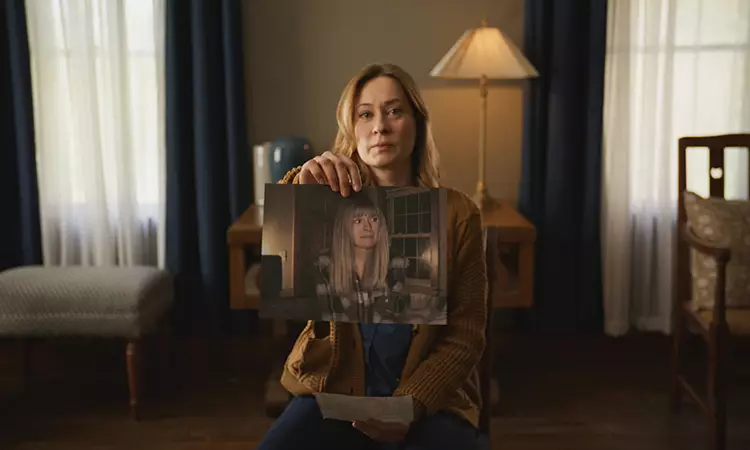In the chilling opening of “Shelby Oaks,” we are introduced to protagonist Riley Brennan, portrayed by Sarah Durn, who articulates a profound sense of dread: “I’m not safe in here; I feel like I’m being watched.” This line not only sets the emotional tone for the film but also creates a stark contrast between what is heard and what is visualized on the screen. Initially, viewers are presented with a blank image while Riley’s voice resonates, evoking a strange yet vivid sense of isolation. The chilling atmosphere thickens when Riley finally appears, her terrified expression punctuating her fearful words, “I’m so scared.” Yet, in a turn of eerie storytelling methods, her utterance drowns in digital distortion, infusing an unsettling ambiguity into her plight. This initial setup serves as an essential metaphor for the broader themes of mediating reality and the obscured narratives that weave through “Shelby Oaks.”
Director Chris Stuckmann masterfully employs a multilayered narrative that segments Riley’s story—found footage interlaced with documentary-style filming—leaving the audience questioning the reliability of their own perceptions. The film chronicles the misadventures of Riley and her colleagues—Peter, Laura, and David—through their investigations into the abandoned “ghost town” of Shelby Oaks, Ohio. Tension escalates when we learn about the grisly fate of her fellow ghost hunters, with the bodies of the trio discovered in a nearby cabin, yet Riley’s fate remains obscured in mystery. Detective Burke, portrayed by Michael Beach, is convinced of her demise, introducing a closer examination of obsession versus reality as Mia Sullivan, played by Camille Sullivan, embarks on a desperate quest for her missing sister.
The juxtaposition of the voyeuristic feel of the found footage and interviews with investigators creates a jarring representation of truth. It compels us to scrutinize how narratives form and how details can become sensationalized for entertainment. Mia’s journey of searching for Riley intertwines with unsettling elements of past experiences, probing us into a disorientating narrative that blurs the lines between familial bonds and psychological horror.
Further enriching the poignant landscape of “Shelby Oaks” is the infusion of occult themes reminiscent of revered horror classics. Stuckmann’s homage to films like Polanski’s “Rosemary’s Baby” and Friedkin’s “The Exorcist” materializes effectively; the specter of the past echoes into the present, reminiscent of Riley’s childhood drawings—ghoulish impressions that seemingly serve as foretastes of the terrifying experiences that Mia faces. As she dives deeper into her investigation, it’s as if she is being pulled into a malevolent force, revealing that there is more than just an eerie unravelling of cold cases—there is a predetermined narrative lurking beneath.
Mia’s quest is marked by her descent into despair, particularly as she neglects her own burgeoning adulthood and desires. The film, with its deep psychological undercurrents, questions the notion of closure and the obsession that may consume loved ones when chasing shadows of the past. This descent reaches a fever pitch when a mysterious figure, presenting an unforeseen threat, interrupts her journey, cementing the view that perhaps the search for truth may unveil deeper horrors beyond comprehension.
Stuckmann’s skillful creation of atmosphere acts like a character unto itself in “Shelby Oaks.” The film adopts a fragmented storytelling style through blurred footage, which encapsulates sensations of haunting nostalgia and foreboding uncertainty, allowing viewers to experience a profound unraveling of sanity alongside Mia. The psychological implications are tension-laden, drawing us into the weighing implications of sisterhood and the instinctual drive to protect loved ones, even as they drift further into the depths of darkness.
Moreover, the multilayered cinematic technique emphasizes not just the tangible horror but also the emotional marrow of grief, loss, and the relentless pursuit of understanding the incomprehensible. “Shelby Oaks” is not merely a tribute to found footage horror or an investigation into the supernatural; it artfully amalgamates psychological and emotional complexity, forcing the audience to confront their own perspectives on truth and fear.
“Shelby Oaks” transcends typical genre expectations through its intricate layering of narrative, emotional depth, and atmospheric tension. It challenges the audience to grapple with their understanding of storytelling—both as an experience of chilling horror and a reflective mirror into human relationships. As Riley’s story meshes with Mia’s haunting search, the film pushes the boundaries of horror, leaving viewers grappling with the disquieting reality that the past will always shadow the present, and that the fears we seek to confine may forever elude us in the labyrinth of memory and legacy.

